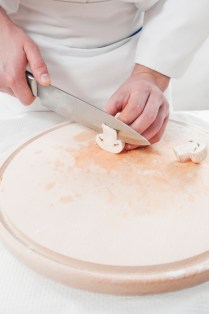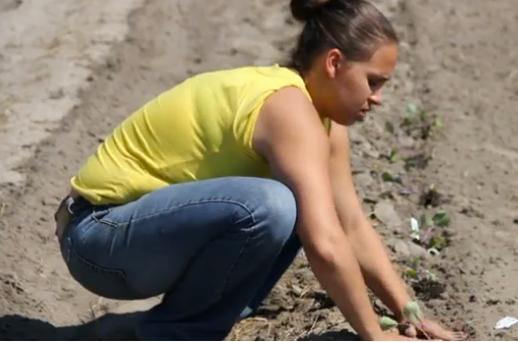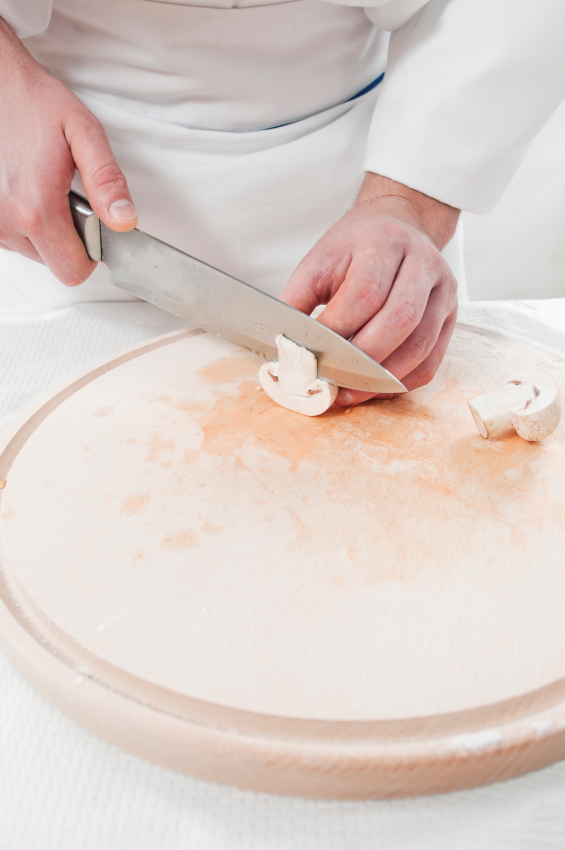 The only thing separating you from eating sustainably on the cheap might be a nice, sharp blade — and the knife skills to use it.
The only thing separating you from eating sustainably on the cheap might be a nice, sharp blade — and the knife skills to use it.
Cooking at home — from scratch — makes it possible for many of us to afford to eat local and organic foods. But the No. 1 barrier people have to cooking at home is time. And, for amateur cooks, following recipes is much more time-consuming without strong knife skills.
The more capable you are in the kitchen, the more flexibility you have when it comes to buying and eating whole, less processed (often more affordable) foods. For instance, two people can get three meals out of one whole chicken for about the same price as buying two pre-cut boneless, skinless chicken breasts. (Of course, the vegetarian equivalent may not apply exactly, but you’ll eat more veggies for your dollar if you’re comfortable cutting and cooking them at home.)
Not that everyone who cooks has knife skills. I cringe in fingernails-on-chalkboard agony when I watch home cooks — and yes, the occasional pro — try to steady a whole onion with a dull blade and their fingers fully extended. What should take about 30 seconds takes 5 minutes, and that’s without a trip to the first aid kit or the hospital. Then they move on to the chicken and I have to look away.
The single most important thing you need to improve your knife skills is a sharp edge. Nothing is more dangerous in the kitchen than a dull blade; it ruins the food and slows you down. If you have the means, there are spectacular knives to be had out there to suit virtually any taste or style. (Here’s a great guide to knives from chef and cooking instructor Samin Nosrat.) The main advantage to the expensive knives, apart from the envy of your friends, is that they hold an edge longer, require less maintenance, and last longer. But the cheap-o blades will suffice if you have a good sharpener and run them across a honing steel before each use.
Let’s talk about the difference between sharpening and honing: Sharpening repairs an edge; honing maintains it. You’ve probably seen the chefs in their stovepipe toques at the carving station during Sunday brunch, methodically rubbing their carving knives against what appears to be a steel rod on a handle. That rod is electroplated with industrial diamond dust, and it removes the spurs, wire edge, and other minor flaws on an edge to keep it sharper longer. Not nearly as expensive as it may sound, the diamond dust is the same manufactured diamond that is in the needle of a good turntable. It will last forever, and all it needs for care is an occasional wash with warm soapy water.
Eventually, however, every knife needs to be taken to a sharpening stone. There are dozens of styles of stones but they all do approximately the same thing — they remove small amounts of metal to recarve the V-shaped edge needed for effective cutting. The more effective your honing (and the better the quality your blade), the less you’ll need a sharpening stone.
Grip is also important element. Grasp the handle of the knife as if you were shaking hands with it, and wrap your index finger around the hilt for better control (not extended forward along the spine). Don’t hold it too firmly, this will only lead to accidents and make you tire sooner. Your guide hand (that’s the one holding the food rather than the knife) should always have the fingers curled under, a little like a hermit crab. This way the guide hand’s knuckles act as a guide as they meet the flat side of the knife.
Cutting techniques vary widely according to the food’s shape. But it’s a good rule to always keep the largest, flattest side of the food face down on the cutting surface. This provides stability so it’s less likely to roll or slip away from you. One other great safety tip: Always place a damp rag under your cutting board. This keeps it from slipping around and causing accidents.
Of course, like any other useful skill, proper knife handling requires practice. The nice thing is that it’s practice that yields delicious results. All the details behind good knife skills could fill a book, and, in fact, they have. I highly recommend The Complete Book of Knife Skills by my friend Jeffrey Elliot with James P. DeWan. It’s full of step-by-step techniques and extremely accurate photography, as well as information about the proper care and handling, and the history of knives.
So get into your kitchen and start practicing. You’ll save money and time and start eating better. And you’ll learn to respect, rather than fear, the blade.



